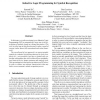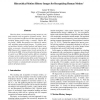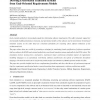797 search results - page 99 / 160 » Spatial Relations Analysis by Using Fuzzy Operators |
ICDAR
2009
IEEE
15 years 6 months ago
2009
IEEE
In this paper, we make an attempt to use Inductive Logic Programming (ILP) to automatically learn non trivial descriptions of symbols, based on a formal description. This work is ...
105
click to vote
EVENT
2001
15 years 1 months ago
2001
There has been a recent and increasing interest in computer analysis and recognition of human motion. Previously we presented an efficient real-time approach for representing huma...
ASE
2008
14 years 12 months ago
2008
Goal-oriented methods are increasingly popular for elaborating software requirements. They offer systematic support for incrementally building intentional, structural, and operati...
129
click to vote
KNINVI
2005
Springer
15 years 5 months ago
2005
Springer
The timeworn claim that a picture is worth a thousand words is generally well-supported by empirical evidence, suggesting that diagrams and other information graphics can enhance h...
BMCBI
2004
14 years 11 months ago
2004
Background: Microarray data must be normalized because they suffer from multiple biases. We have identified a source of spatial experimental variability that significantly affects...



